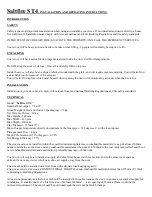
MAINTENANCE
1) A minimum of once per year the flue system should be
cleaned/swept by a qualified chimney sweep or suitably
qualified stove installer. The servicing of the appliance
can usually be carried out at the same time. Whether the
system needs sweeping more frequently than this will
depend on use.
2) Baffle plate should be removed and checked above for
debris - To remove the baffle, first remove the grate and
ashpan/ burn-tray then push the baffle into the roof of the
stove and with one hand, hold it there - this will release the
left and right side firebricks which with the spare hand can
then be carefully removed in turn. The baffle can then be
dropped down and manoeuvered out of the stove.
Warped/misshapen baffle plates can be a warning sign that
the stove has been over-fired (allowed to excessively heat
on one or more occasions).
3) Brush the baffle using a stiff brush or wire brush to
remove any deposits. Clear any debris from the upper parts
of the stove above where the baffle normally sits.
4) Inspect firebricks on both the sides for cracks and shape
distortion (caused by excessive heating) and replace if
necessary.
5) Inspect grate and burn-tray/ ashpan for shape distortion
or excessive heat damage. Replace any damaged or
warped components without delay.
6) Vacuum or brush out the inner stove box thoroughly.
7) Visually check that the glass is still making a good seal
against its rope on the inside of the door frame and that its
retaining clips remain firmly in place to the touch.
8) Check that the door is making a good seal with the body
of the stove all around (over time the rope will flatten out
and loose some flexibility - when this happens and when it
is no longer sealing fully all the way round, it needs to be
replaced). The rope size used here is a
8mm-Soft type.
9) Blemishes or scratches to the paintwork can be touched
up using a suitable high temperature stove paint in a spray
can. Ensure the stove is cool and clean before applying
and follow the paint manufacturer’s instructions.
Contact Ekol directly if you are unsure which paint to use.
At least Annually.....
Throughout the season, it is good practice to keep the
stove in generally good clean order which will prolong the
life of serviceable components and enhance the experience
you have with your fire.
1) NEVER wipe the stove in the early stages (prior to paint
fully curing), as the paint will be very soft and will damage
easily.
NEVER attempt to clean or wipe the paint surface when
warm or hot.
2) To keep the outer body clean, simply dust over with a
clean soft duster when cold.
3) If there are marks which cannot be removed with a
duster, use a slightly moistened cloth very gently, but only
when the stove is cool and has not been in use. Then
pat dry with absorbent paper towel. Ensure all residues
are removed from the surface when using a damp cloth,
otherwise paint damage / discoloration can occur when
re-heated.
4) Regularly clear the firebox of ashes and debris using a
small dustpan and brush or a vacuum but only when cool.
5) Regularly vacuum soot and dust from around the inside
of the door and around the glass and rope seals.
6) If glass gets dirty on the inside from soot, clean
with liquid ‘stove glass cleaner’ and a soft cloth OR
with an “Atmosfire Dry Wiper” produced by Schott (the
manufacturers of ceramic stove glass) and available online.
Do this as soon as possible once the soot appears, but
only when the fire is completely cool. Never use newspaper
or soot or any other abrasive or cleaning method on the
glass.
More Frequently as required....
page
10
Содержание ApplePie
Страница 23: ...page 23...











































